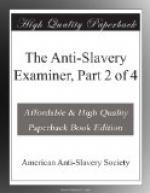At the other end of the market-place stood the Lock-up House, the Cage, and the Whipping Post, with stocks for feet and wrists. These are almost the sole relics of slavery which still linger in the town. The Lock-up House is a sort of jail, built of stone—about fifteen feet square, and originally designed as a place of confinement for slaves taken up by the patrol. The Cage is a smaller building, adjoining the former, the sides of which are composed of strong iron bars—fitly called a cage! The prisoner was exposed to the gaze and insult of every passer by, without the possibility of concealment. The Whipping Post is hard by, but its occupation is gone. Indeed, all these appendages of slavery have gone into entire disuse, and Time is doing his work of dilapidation upon them. We fancied we could see in the marketers, as they walked in and out at the doorless entrance of the Lock-up House, or leaned against the Whipping Post, in careless chat, that harmless defiance which would prompt one to beard the dead lion.
Returning from the market we observed a negro woman passing through the street, with several large hat boxes strung on her arm. She accidentally let one of them fall. The box had hardly reached the ground, when a little boy sprang from the back of a carriage rolling by, handed the woman the box, and hastened to remount the carriage.
CHRISTMAS.
During the reign of slavery, the Christmas holidays brought with them general alarm. To prevent insurrections, the militia was uniformly called out, and an array made of all that was formidable in military enginery. This custom was dispensed with at once, after emancipation. As Christmas came on the Sabbath, it tested the respect for that day. The morning was similar, in all respects, to the morning of the Sabbath described above; the same serenity reigning everywhere—the same quiet in the household movements, and the same tranquillity prevailing through the streets. We attended morning service at the Moravian chapel. Notwithstanding the descriptions we had heard of the great change which emancipation had wrought in the observance of Christmas, we were quite unprepared for the delightful reality around us. Though thirty thousand slaves had but lately been “turned loose” upon a white population of less than three thousand! instead of meeting with scenes of disorder, what were the sights which greeted our eyes? The neat attire, the serious demeanor, and the thronged procession to the place of worship. In every direction the roads leading into town were lined with happy beings—attired for the house of God. When groups coming from different quarters met at the corners, they stopped a moment to exchange salutations and shake hands, and then proceeded on together.




